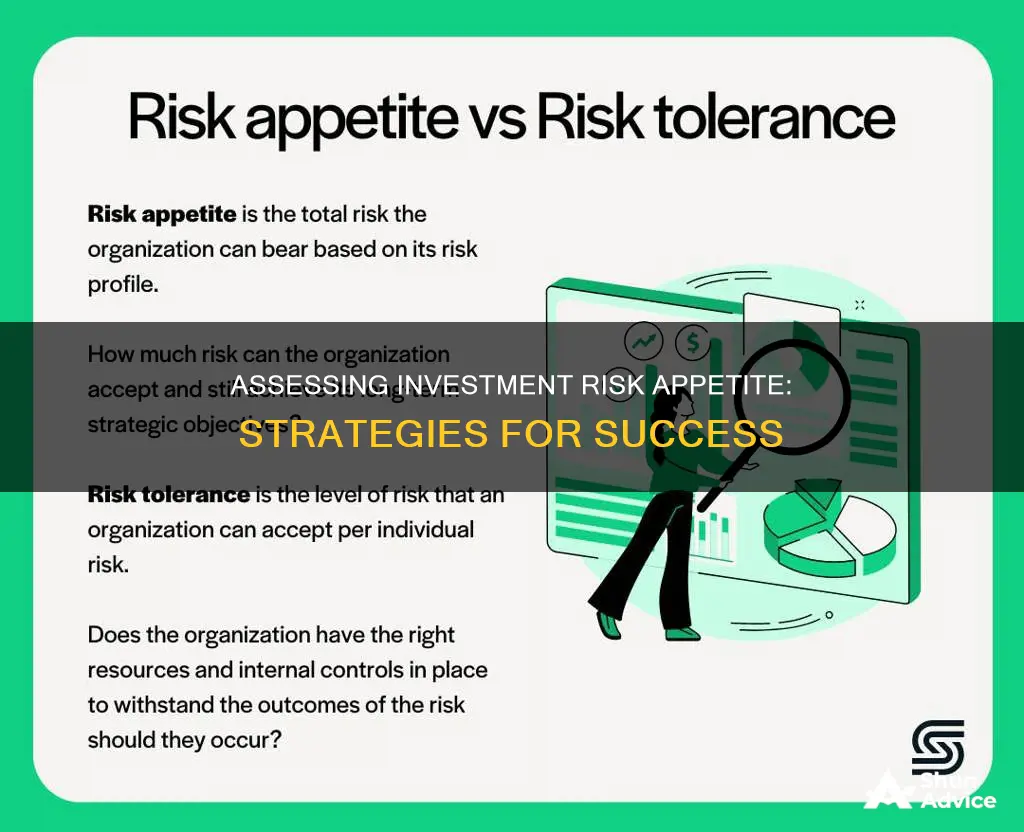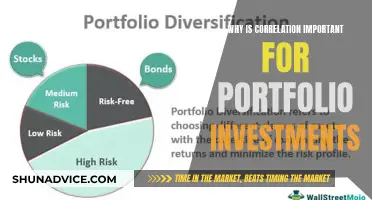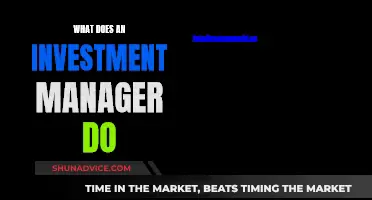
When it comes to investing, one of the most important things to figure out is your risk appetite or how much risk you can handle. This will depend on a few things, like your personal attitude towards risk, how much risk is needed to meet your goals, and how much you can afford to lose. It's important to get a sense of this before investing, as taking on too little or too much risk can be dangerous. While it's not an exact science, there are a few ways to get a better understanding of your risk tolerance.
| Characteristics | Values |
|---|---|
| Risk tolerance | How much risk an individual can handle |
| Investment goals | Financial objectives |
| Investment timeframe | Age and time to reach financial goals |
| Investor's capacity for risk | Ability to absorb losses |
| Comfort with risk | Emotional standpoint |
| Investment preference tests | Questionnaires addressing preferences for investment vehicles |
| Psychological tests | Questionnaires gauging attitude toward risk |
What You'll Learn

How much risk can you stomach?
When you start investing, determining your risk appetite should be your first step. You might be comfortable navigating the market's highs and lows, or you may find the uncertainty of an aggressive investment strategy too stressful. So, how much risk can you stomach?
Financial advisor Mark Gartman says that if you want to achieve financial growth, you need to have some financial and emotional tolerance for risk. That's because if you find it too stressful to watch your portfolio value fluctuate, you might act impulsively. "Pulling your money out at the slightest market fluctuation may not be a good idea," Gartman says. "You can end up losing money over the long run."
There are two aspects of risk tolerance: an investor's capacity for risk, or ability to absorb losses, and how comfortable an investor is with risk. An investor's capacity for risk is determined from a financial point of view—how much money can they afford to lose? An investor who depends on their investments to pay daily expenses and for whom a loss would be a serious problem has less risk tolerance than someone for whom a loss would be a mere inconvenience.
How comfortable an investor is with risk, from an emotional standpoint, depends on many factors, including their objectives, goals, life stage, personality, knowledge of investing, and investment experience. Some investors will hang on to their investments during market downturns, while others will bail out at the first sign of trouble. If you find yourself losing sleep over your investments, you may have invested too much or too aggressively.
Investors typically fall into three categories of risk tolerance: aggressive (risk-tolerant), conservative (risk-averse), or moderate (somewhere in between). To determine which category you fall into, you can take a risk tolerance test. These tests are designed to give you a general sense of how much investment risk you can accept, and the results are generally considered reliable. They can be categorised into two types: investment preference tests and psychological tests.
The Collar Investment Strategy: What Makes it Tick?
You may want to see also

What are your investment goals?
When it comes to determining your investment risk appetite, one of the most important questions to ask yourself is, "What are your investment goals?" Here are some things to consider when thinking about your investment goals:
Be Clear and Specific
It is important to be clear and specific about your investment goals. Think about what you want to achieve financially and make sure your goals are measurable and attainable. For example, do you want to save for a down payment on a house, or are you planning for your child's college fund? Write down your goals to make them seem more tangible and to serve as a reminder to stay committed to them.
Consider Your Risk Tolerance
Your investment goals will depend on your risk tolerance, which refers to how much investment risk you are comfortable with. If you have a low-risk tolerance, you may want to build a portfolio with less investment risk, such as investing in more stable assets like bonds or dividend-paying stocks. On the other hand, if you have a higher-risk tolerance, you may be comfortable with more aggressive investment strategies, such as investing in growth stocks or emerging markets.
Time Horizons
Different investment goals will have different time horizons. For example, if you are saving for a house, you may have a shorter time horizon of a few years, while saving for retirement may have a time horizon of several decades. Your investment strategy will need to align with your time horizon, as more aggressive investments may not have time to recover from market fluctuations in the short term.
Diversification
Diversification is an important consideration when setting your investment goals. Diversifying your portfolio across different asset classes, sectors, and geographic regions can help mitigate risk while still working towards your financial goals. This way, you are not putting all your eggs in one basket, and you can benefit from the growth of different areas of the market.
Life Stage and Income
Your life stage and income will also play a role in determining your investment goals. For example, if you are young and just starting out in your career, you may focus on shorter-term goals like saving for a house or starting a family. As you progress in your career and your income grows, you can then start to focus on longer-term goals like retirement planning.
Regular Review
It is important to regularly review your investment goals and make adjustments as necessary. Life circumstances can change, and the investment strategy that worked for you a few years ago may no longer be suitable. Review your progress towards your goals and make small adjustments to stay on track.
A Guide to Investing in India's Sensex Index
You may want to see also

What is your investment timeframe?
When determining your investment risk appetite, it is crucial to consider your investment timeframe, which is the period you expect to hold an investment before needing the money. This timeframe is a key factor in shaping your investment strategy and directly influences the level of risk you should be willing to take on.
Your investment timeframe is closely tied to your age and financial goals. For instance, if you are in your 20s, starting early on your investment journey, you may be able to tolerate a higher level of risk as you plan for retirement 30 to 40 years in the future. As a rule of thumb, the longer your investment timeframe, the more risk you can take on as short-term fluctuations are less likely to impact your returns.
On the other hand, as you get closer to retirement, your risk tolerance will likely decrease because you have less time to recover any losses due to market volatility. In this case, you may want to shift towards lower-risk investments to prioritise certainty and stability.
It's important to regularly review your investment horizon and adjust your portfolio accordingly as your financial goals evolve. For example, if you initially started with a long-term horizon but now need the funds sooner, it would be prudent to move towards lower-risk investments.
- Short-Term (up to 3 years): Investors with a short-term horizon usually have a lower risk tolerance and should opt for safer options like money market funds, fixed investments, short-term corporate bonds, certificates of deposit (CDs), and Treasury bills.
- Medium-Term (3 to 5 years): Investors with a medium-term horizon often go for a more conservative mix, such as 70% bonds and 30% stocks.
- Long-Term (more than 5 years): Long-term horizons allow for a higher allocation of riskier assets, including stocks, mutual funds, exchange-traded funds (ETFs), long-term corporate bonds, real estate, and private equity funds.
Remember, your investment timeframe is a critical factor in crafting a successful investment strategy. By aligning your timeframe with suitable investments and maintaining a long-term perspective, you can navigate the financial markets with confidence and increase the likelihood of achieving your investment goals.
Building an Early Investment Portfolio: A 20-Something's Guide
You may want to see also

What is your personal attitude to risk?
When it comes to investing, your personal attitude to risk is a critical factor in determining your investment strategy. This is influenced by your emotional tolerance for uncertainty, your financial goals, and your capacity for loss.
Some individuals are comfortable with the highs and lows of the market and can withstand the stress of an aggressive investment strategy. Others may find the fluctuations in their portfolio value too stressful and may prefer a more conservative approach.
Your personal attitude to risk can be assessed through questionnaires or quizzes that evaluate your comfort with uncertainty and your willingness to take risks. These assessments consider factors such as your life stage, personality, knowledge of investing, and previous investment experience.
For example, a simple quiz might ask: Do you typically take the familiar route or a shortcut? Do you fill up your gas tank when it's halfway empty or push it to empty? These questions relate to your comfort with uncertainty and your willingness to take risks.
Your personal attitude to risk is just one aspect of determining your overall risk appetite for investing. It's essential to consider this alongside your financial goals and capacity for loss to make informed investment decisions.
Investments for a Comfortable Retirement at 59 Years Old
You may want to see also

What is your capacity for loss?
When making an investment, it is crucial to assess your capacity for loss. This refers to your financial ability to withstand potential losses without significantly affecting your financial stability or lifestyle. It is a practical measure that assesses whether you can afford the potential consequences of your investment choices.
For instance, an individual with a high-risk appetite and a desire for riskier investments and higher returns may have a low capacity for loss due to their limited financial resources. On the other hand, someone with a low-risk appetite, ample financial resources, and a frugal lifestyle may consider taking on more investment risk to make their money work harder for them.
Assessing your capacity for loss can be challenging, as people often overestimate or underestimate their financial resilience. Professional tools, such as cash flow modelling, can help gain an accurate understanding by providing in-depth financial projections and outlining different scenarios. This process involves establishing a base plan that reflects your current financial situation, including assets, income, and living expenses, and then exploring various scenarios, such as market downturns or shifts in investment strategies, to understand their potential impact on your financial well-being.
By comparing these scenarios, you can visualise your capacity for loss and make more informed investment decisions that align with your goals and circumstances. This holistic approach to financial planning ensures that your investment strategy takes into account your current financial circumstances and how your needs may change over time.
Investments vs Savings: Understanding the Key Differences
You may want to see also
Frequently asked questions
Your investment risk appetite is determined by three main attributes: your personal attitude to risk, how much risk is needed to achieve your investment goals, and your capacity for loss.
As risk increases, the potential for return increases. This is known as the risk-return tradeoff. Historically, investments with greater risk have tended to provide higher returns.
Your risk appetite can rise and fall along your investment timeline, which is influenced by your age and how much time you have to reach your financial goals. For example, your risk tolerance will likely decrease as you near retirement since there is less time to recover any money lost due to market fluctuations.







